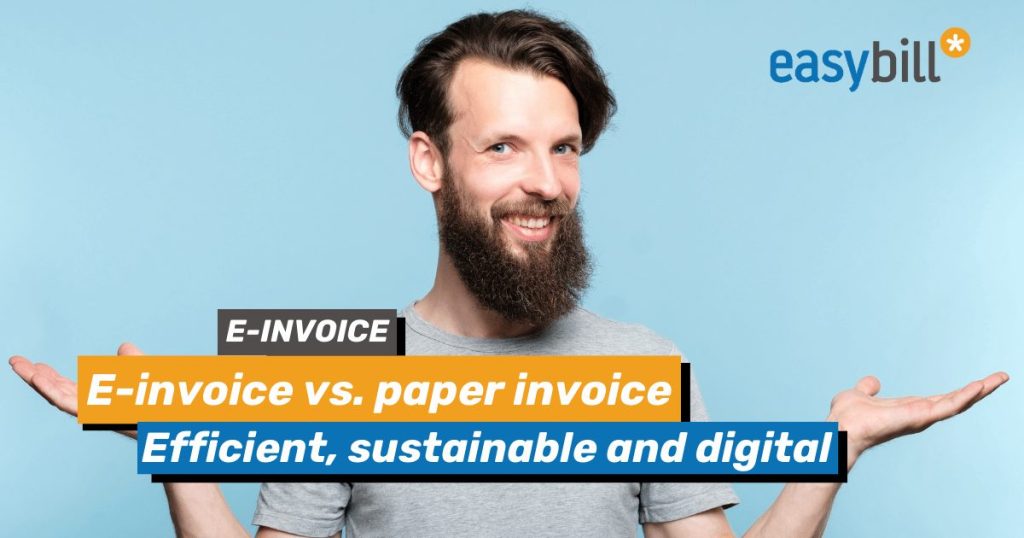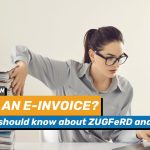
In today’s digital world, we are experiencing an increasing shift from analog processes to digital alternatives. One of these changes is the introduction of mandatory e-invoicing on 1.01.2025. But what exactly are the advantages of e-invoicing over paper invoices? Why should companies switch to this modern format as soon as possible?
In this article, we look at the comparison between e-invoicing and paper invoicing. In particular, we look at the advantages of e-invoicing for companies in the context of advancing digitalization.
E-invoice vs paper invoice: a basic comparison
Before we go into the advantages, it is worth briefly comparing the two types of invoice.
Paper invoice
A paper invoice is the traditional method of printing invoices on paper and sending them by post. This process requires not only paper and a printer, but also time for sending and receiving.
Archiving is also more time-consuming, as physical documents have to be filed and searched manually if necessary.
E-Invoice
An electronic invoice (e-invoice for short) is a digital document that is sent and received directly via the Internet. The e-invoice can be available in various file formats such as XML or PDF with embedded XML and is often integrated directly into accounting systems.
The best-known formats in Germany are currently the XRechnung (B2G sector) and the ZUGFeRD format (B2B sector).
The advantages of the e-invoice over the paper invoice
We have efficiently summarized our top 6 advantages for you. If you’re not already convinced of the benefits of e-billing, perhaps you’d like to read this?
#1: Time savings and efficiency
One of the biggest arguments in favor of e-invoicing is the enormous amount of time it saves. Compared to paper invoices, there is no need for printing, enveloping and franking. Instead, the e-bill is sent with just a few clicks, which speeds up the entire process. Receipt is also much faster: while a paper bill can take days or even weeks to arrive, an e-bill is delivered in seconds.
By processing invoices digitally, companies can significantly reduce processing times and receive payments more quickly. This greater efficiency leads to better liquidity and reduces the risk of late payments.
#2: Cost reduction
Companies can save considerable costs by switching to e-invoices. Paper invoices require paper, printer ink, envelopes and postage. These physical costs are completely eliminated with e-invoicing. The costs of manually processing and archiving invoices are also reduced.
#3: Error reduction and automation
When processing paper invoices manually, errors can easily occur – whether when entering data or manually entering it into accounting systems. E-invoices enable automatic data processing, which minimizes sources of error. Many modern accounting systems can read e-invoices directly and automatically post the information they contain.
Digitization brings a decisive advantage here: automated processes reduce the susceptibility to errors and leave more time for other important tasks in the company.
#4: Environmental friendliness and sustainability
In times of climate change and sustainability debates, the environmental friendliness of processes is becoming increasingly important. Paper invoices contribute to deforestation, as paper is produced from wood. In addition, printing and mailing cause high CO₂ emissions. The e-bill offers a sustainable alternative. As no physical materials are required, there is no paper waste and there are no CO₂ emissions from transportation.
Companies that switch to e-invoices actively contribute to environmental protection and at the same time strengthen their image as a sustainable organization.
#5: Legal security and transparency
In many countries, including the EU, e-invoices are recognized as fully-fledged and legally valid documents. The advantages of e-invoices for companies also lie in the improved traceability: e-invoices can be archived in an audit-proof manner and the digital transmission means that complete documentation of invoice creation and delivery is retained. This makes the process more transparent and easier to trace in the event of an audit.
In Germany, the GoBD also plays a decisive role. easybill as GoBD-compliant invoice software strictly adheres to the specifications and prevents the deletion of tax-relevant documents. Subsequent editing, on the other hand, is safeguarded by the creation of new versions of a document. Everything is compliant and absolutely secure for your company and traceability by the tax authorities.
#6: Space-saving archiving
Archiving paper invoices requires a lot of space and resources. Every company is obliged to keep invoices for a certain period of time (currently 10 years in Germany), which can lead to mountains of paper. In contrast, e-invoices can be archived securely and space-savingly on servers or in the cloud without taking up physical space. Digital filing also makes it quick and easy to search for old invoices.
Why the e-invoicing is the future
The advantages of e-invoicing over paper invoices are numerous and convincing. Not only does it offer considerable time and cost savings, it is also an environmentally friendly and sustainable alternative. E-invoicing is becoming increasingly attractive for companies, especially as digitalization progresses, as it brings efficiency, transparency and security to the billing process.
Companies that still rely on paper invoices should therefore seriously consider switching to e-invoices now. The benefits of e-invoicing for companies are clear: from cost reduction and process automation to increased sustainability. In an increasingly digitalized world, e-invoicing is not only the modern choice, but also the future-proof one.
Read also:
VAT in the gastronomy sector: success strategies for businesses
Craftsman invoice: show labor costs and material costs separately
Create e-invoices in ZUGFeRD 2.2 format (german Help center)


